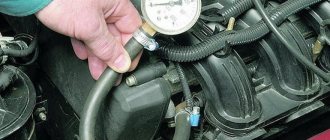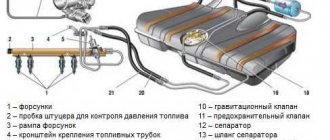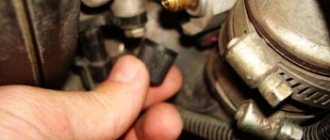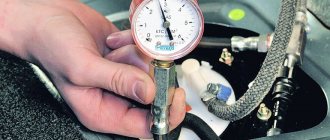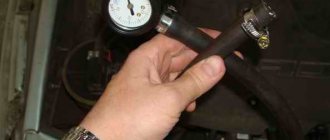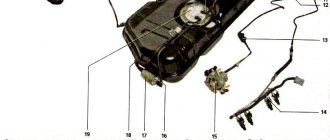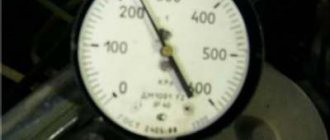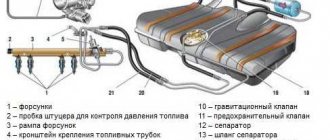For normal engine operation, timely supply of fuel at the required pressure is required. If interruptions or vibrations occur in the engine, it begins to “trouble”, very often this is due to the supply of fuel to the combustion chambers. One of the main tests that will help identify and fix the problem is measuring the pressure in the fuel rail. In the service, such diagnostics cost at least 900 rubles, but in order not to waste money and time, you can do everything yourself.
What is a fuel rail
A fuel rail is a special hollow rail through which fuel passes, being distributed through smaller diameter pipes and then through injectors before being supplied to the combustion chambers. This structural element is installed on both diesel and gasoline engines with an injector. That is, it is found in every modern engine.
The fuel rail is located on the intake manifold and is securely attached to the block. Since its operation requires high fuel pressure in the fuel system, it is made of high-quality, durable and corrosion-resistant steel. A fuel pressure regulator is also installed here, which holds it when the ignition is on but the engine is not running. This is necessary for the timely supply of fuel at startup.
Measuring devices
To check the pressure of the fuel pump with your own hands, you need to prepare a set of simple devices:
- a pressure gauge designed for a maximum pressure of 10 Bar (1 MPa), a suitable device for checking tires;
- gasoline hose with an internal diameter of 8 mm;
- a cap for unscrewing spool valves from wheel valves;
- clamping clamps 10–15 mm – 2 pcs.
To take measurements at other points in the fuel supply circuit, you will need homemade adapters to connect a gasoline hose with a pressure gauge. If the line is assembled with quick-release plastic connections, you need to buy one such clamp with a fitting. To connect to a threaded joint, purchase the appropriate tube with nuts and cut it into 2 parts.
When is it necessary to check the fuel pressure in the rail?
There are several signs that indicate problems with the fuel system:
- Increased fuel consumption in all operating modes.
- Unstable operation at idle speed, the engine may often stall, especially after sharply pressing the gas pedal.
- All cylinders do not start - the engine “troubles”.
- Long-term starting after inactivity due to reduced pressure in the injectors.
- The intensity and toxicity of the exhaust increases.
Similar symptoms often occur with other breakdowns, but before making more complex and expensive diagnostics, it makes sense to check the fuel pressure in the rail yourself. If it is low, you need to react immediately, identifying the malfunction.
Diagnostic instructions
The first step is to free access to the ramp and fitting installed at the end of the manifold. Remove elements that interfere with measurements - air duct, filter housing, crankcase ventilation pipe, etc. (the list of parts depends on the car model). Proceed to measuring, following the instructions:
- Unscrew the protective plastic cap from the diagnostic fitting on the ramp.
- Place a cut-off plastic container and use a cap to unscrew the spool valves to release the pressure previously pumped up by the pump. You can press the valve or turn the spool 2-3 turns.
- Place one end of the gasoline hose onto the pressure gauge fitting and secure with a clamp. Unscrew the spool from the manifold, pull the second end of the hose onto the pipe.
- Turn on the ignition, and the electric fuel pump will pump fuel into the system. Make sure there are no leaks at the joints of the diagnostic tool.
- Start the engine and record the fuel pressure in the rail using the pressure gauge.
Advice. It is better to take readings from the device twice - after turning on the ignition and starting the engine. If you notice a difference, you need to additionally check the regulator and fuel pump.
The pressure level in the fuel supply circuit depends on the design of the system. In cars where the RTD and the discharge tube - “return” - are located in the engine compartment, the pressure gauge should show 2.7 Bar. The upper and lower permissible limit is 2.7–3.0 Bar. If the measured values are outside the specified range, you should continue the diagnosis and find the cause of the problem.
On many cars, including VAZ, the pressure regulator and the fuel return hose are located next to the fuel pump. The normal manifold pressure for such machines is 3.8 Bar, the maximum value is 4 Bar.
If during the measurement process periodic pressure surges within 0.2 bar are observed, the primary strainer needs to be cleaned or replaced. Typically, it is installed in the gas tank along with an electric pump.
A device for measuring pressure
The main part of the device for measuring pressure is a liquid pressure gauge with a measurement limit of no more than 8 atmospheres. It costs 300-400 rubles. Next, you will need fuel pipes of a suitable size, possibly from a VAZ, a tee, a set of clamps and quick-release fittings that can be removed on old fuel pumps.
If desired, you can buy a special kit that can be used to measure pressure in the fuel system. It works on the same principles, but will cost slightly more than a homemade assembly. Its advantage is that the set includes several sets of fittings for various fuel supply systems, and the price of the device depends on this.
Car won't start after DIY replacement
This is a fairly common problem. It must be said that the car should not start immediately after replacing the pump. The pump first needs to create operating pressure in the system. To do this, you need to turn on the ignition for a short time (a few seconds). The key must be inserted into the lock, but not turned. The lights on the dashboard should light up. Then you can rotate the engine with the starter for five to ten seconds. If nothing works out, then you should take a break for half a minute and repeat your actions.
We recommend: How to choose the right winter tires for your car?
If the engine does not start even after several cranks with the starter, this indicates that shortcomings were made during assembly and connection of the fuel pump. Another reason could be a malfunction of the new pump. There is also a possibility of a planned blocking or failure of the car’s security system.
When a car owner installs and connects a new unit, various failures may occur: sticking of valves on the pump, breakage of contacts, terminals and connectors. When such problems arise, you need to try to determine their nature. Did the breakdown occur in the mechanical or electrical part of the fuel pump? The easiest way to find out is if there is a problem with the power supply. You also need to remember that the fuel filter may become clogged.
In order to accurately determine the causes of the problems, you need to make sure that the fuel rail does not contain gasoline. After this, you need to re-remove and connect the pump directly from the battery or dimensions. This method of connecting the pump is the best for quickly checking it.
A car owner must take care of every part of the car. It is best to gain knowledge about its structure and repair yourself. It is important to acquire skills in diagnosing and solving problems in the operation of individual machine systems. This also applies to the functioning of the fuel pump.
Many drivers encounter breakdowns on the road, far from cities and service points. In such a situation, you can only rely on your own experience. Knowledge about the signs and causes of malfunctions in the fuel pump will help solve problems at the initial stage of their occurrence. It will also save effort, time and a significant part of personal funds.
Measuring process
Before starting the measurement, you need to turn off the engine and cover the place where the ramp is connected to the fitting with a rag, which will quickly absorb the gasoline that spills out when disconnected. In this case, you need to be prepared for the fact that the fuel may splash out, since it is under residual pressure.
After disconnecting the fitting, you need to insert the device into the resulting gap, after which the reliability of the connection is checked. In this case, the pressure gauge will show zero pressure - this is normal, since the tightness of the fuel line has been broken. Only then can you check the pressure in the fuel rail.
After installing the device, the ignition is turned on, the pump begins to pump fuel and the pressure gauge shows a certain pressure. In this case, the established value should not decrease, remaining stable in the region of 2.5-4 atmospheres. At the next stage, the engine starts, the pressure of the fuel pump increases by several tenths of an atmosphere, which is reflected on the pressure gauge. After stopping the engine, the pressure should return to the previous value, but not drop to zero.
If, when you disconnect the fitting before installing the device, the pipe is empty, this indicates reduced pressure, which is the first sign of problems with the fuel system. This indicates a breakdown of the pressure regulator. Another sign of failure of this unit is a drop in pressure shortly after turning on the ignition, as soon as the fuel pump stops pumping fuel into the system.
After starting the engine, the pressure can be stable, since the pressure regulator does not play any role in this case. The regulator needs to be replaced and can be done at little cost. If the engine is unstable and the pressure decreases as the speed increases, the problem is in the fuel pump.
Video: Measuring the pressure in the fuel system
Standard pressure values
In the first case, when the ignition is turned on, the pressure in the fuel system should be within three atmospheres and not drop below this level. Idle speed may show a pressure of about two atmospheres, which is also normal. Without a pressure regulator tube, the reading should be three point three atmospheres. But a compressed tube will indicate a pressure of up to seven atmospheres. There is one more optional parameter. We are talking about pressure when accelerating. It should increase to three atmospheres, after which it should immediately descend to a level of two and a half atmospheres.
And, remember that you need to make sure that there is no damage to the fuel system, otherwise the readings will differ significantly from the real ones.
What are the causes of pressure drop in the fuel system?
A drop in fuel pressure in the system is one of the signs that its components are failing. After this, additional diagnostics will be required to help identify the problem and replace the part. The main reasons for the drop in pressure in the fuel line:
- damage or wear of the fuel hose or rubber seals;
- nozzles do not hold;
- the fuel pump is worn out;
- pressure regulator failure.
Despite certain discomfort, for example, the car will start up worse, accelerate less, or smoke during operation, it will still be possible to drive it. But the fuel pump will already work in extreme conditions, since the sensors will require to maintain the nominal pressure and will wear out faster. As a result, it will fail. If the problem is identified in a timely manner, you can limit yourself to simply replacing the pipe, seal and fuel pressure regulator.
Thus, by making a simple device with your own hands, you can significantly extend the service life of the fuel pump and injectors, promptly identifying problems that lead to a drop in pressure in the fuel system. This will significantly reduce the cost of operating the car.
Seal
How to measure?
Of course, a special set with fittings, hoses and a pressure gauge is the ideal choice.
But, if one is not available, then the kit can be assembled from improvised means. The central unit of the measuring equipment is the pressure gauge. During measurements, the maximum pressure will fluctuate within 6 atmospheres, so the device must be designed for at least 7-8 atmospheres. As for the graduation of the scale, it is more convenient for it to be in atmospheres.
Valuable practical advice is to use a pressure gauge to measure tire pressure: the scale is convenient, and the nominal bore of the tube is 8 mm. It is worth noting that a gas pressure gauge is also suitable for similar purposes. However, the diameter of the outlet fitting is usually larger. For example, for a 1.0 MPa device this value is already 9 mm.
Attention! 0.1 MPa is approximately 1 atmosphere.
In addition to the pressure gauge, you need a rubber hose and a pair of clamps. This is the minimum kit. If you need to turn off the fuel pressure regulator on systems without a “return” or measure the pressure at the inlet to the fuel rail, you will need a plug and an adapter fitting, respectively. Since the design of the switching unit between the fuel line and the ramp can be different, the adapter must be selected locally. As a first approximation, it is worth noting that there are threaded and quick-release designs.
Symptoms of a vehicle problem
The following signs may clearly indicate a malfunction in the vehicle.
- Engine tripping.
- Unstable operation of the XX mode.
- Interruptions and increased fuel consumption.
- Unexpected engine stops in idle mode.
- High content of harmful CO in the exhaust system.
As a rule, if the symptoms described above are present, but the ECU does not show anything, the problem is in the fuel frame of fuel-injected internal combustion engines. By checking the pressure, you can verify this assumption.

